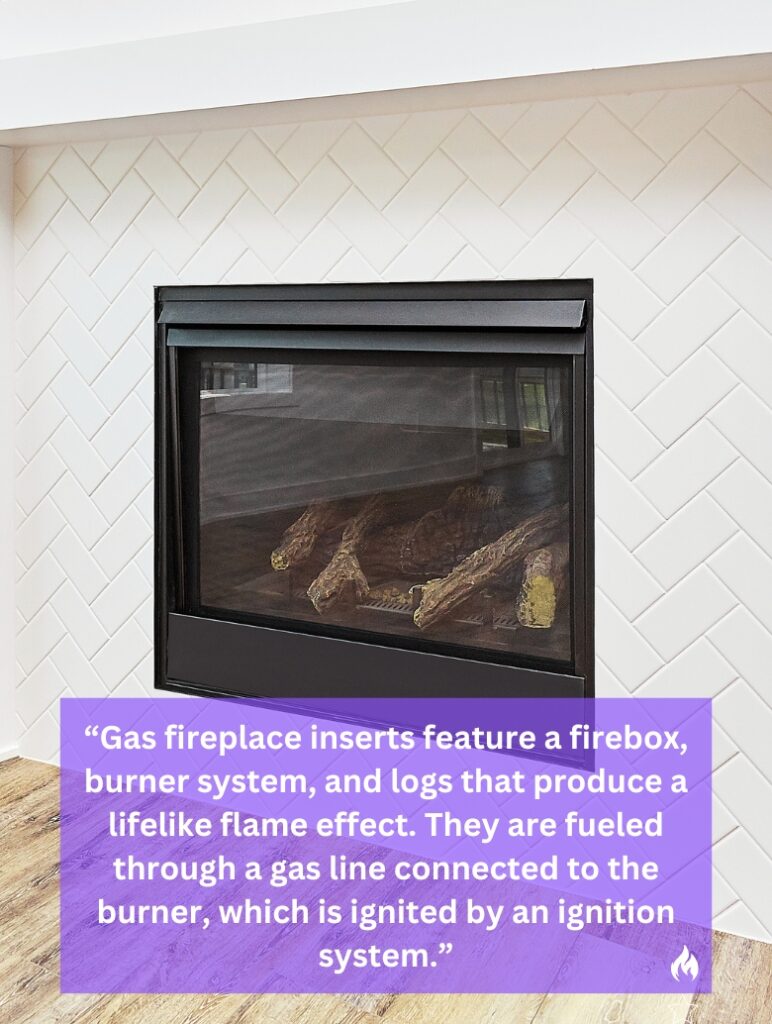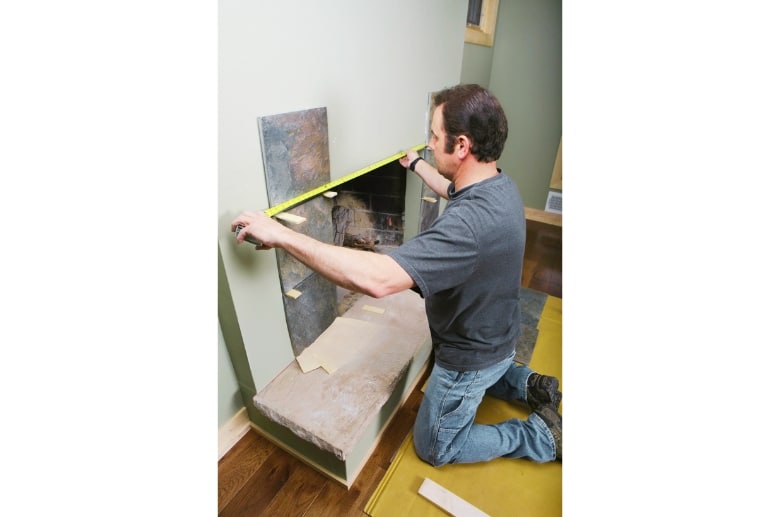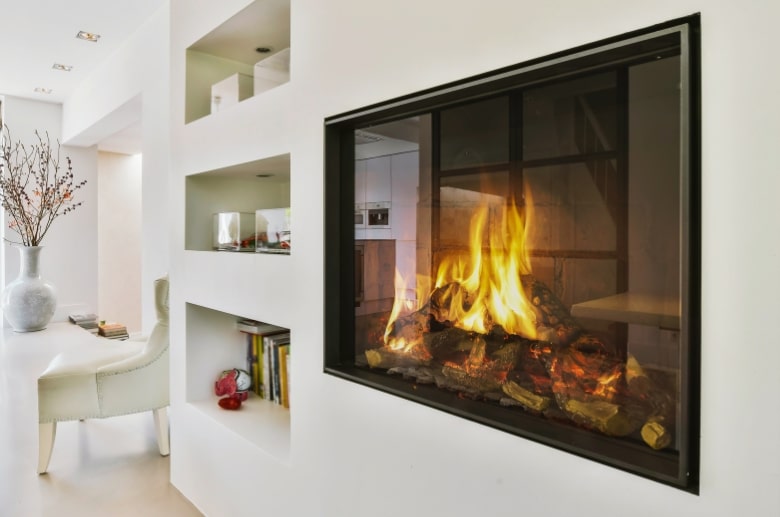Do you dream of cozy nights by a crackling fire but dread the thought of chopping wood or dealing with ashes? Gas fireplace inserts might be your perfect solution!
These nifty little devices are designed to fit snugly into your existing fireplace, transforming it into a clean, convenient, and energy-efficient source of warmth and ambiance. No more messy firewood, smoky clothes, or hours spent cleaning up.
But how do gas fireplace inserts work?
Keep reading because this article explores the intricate mechanisms behind these devices. So, grab your favorite mug of hot cocoa, settle in, and let’s get this fire started!

How Do Gas Fireplace Inserts Work?
Gas fireplace inserts feature a firebox, burner system, and logs that produce a lifelike flame effect. They are fueled through a gas line connected to the burner, which is ignited by an ignition system. These inserts use either natural gas or propane as fuel, offering a regulated and efficient heating solution.
There are two types of venting systems: direct venting and vent-free. The flame height and temperature can be adjusted using remote controls or wall switches. These inserts are designed to increase both the efficiency and visual appeal of traditional fireplaces.
Here’s a more elaborate breakdown of how gas fireplace inserts work:
Structure and Components
The core structure of a gas fireplace insert typically consists of a sturdy steel or cast iron box. This box serves as the enclosure for the combustion process, ensuring safety and directing heat into the room. Over time, wear and tear may necessitate fireplace insert repair to maintain this crucial safety and efficiency. Regular maintenance of these components can prevent more extensive repairs in the future.
Additionally, the front of the insert is often fitted with insulated glass, allowing a clear view of the flames while preventing excessive heat from escaping. This feature enhances safety and energy efficiency.
The insert functions as a self-contained unit, radiating heat back into the room and enhancing warmth. By retrofitting into existing fireplaces, these inserts reduce inefficiencies, like heat loss through the chimney, associated with traditional setups. They do this by:
- Trapping heat: The closed design prevents heat from escaping up the chimney, maximizing its use in the room.
- Controlled burning: Inserts optimize airflow and fuel usage, leading to longer-lasting fires with less wasted fuel.
——
Do You Need to Hire Chimney & Fireplace Expert?
Get free quotes from qualified experts near you. No commitment required!
——
Detailed Working Mechanism
This is where the magic happens since gas fireplace inserts operate by connecting to a natural gas or propane supply. The ignition process begins with a pilot flame, a small continuous flame that serves as the ignition source.
Once lit, the main burner flames are activated, providing heat. Flame size and heat output can be adjusted using a control knob or remote.
Moreover, adequate ventilation is crucial, as it ensures proper combustion and expels waste air. Safety features include automatic shut-off mechanisms triggered by malfunctions or low oxygen levels.
Oxygen Depletion Sensors (ODS) further enhance safety by detecting reduced oxygen levels and shutting off the gas supply, preventing potential hazards.
Installation and Maintenance

Installing a gas fireplace insert is a breeze compared to traditional wood-burning setups. The process involves a few key steps:
- Prep the space: Clear out the fireplace, removing any old grates, logs, or screens. A professional can assess the chimney flue for proper venting and make any necessary adjustments.
- Connect the utilities: Run a dedicated gas line and electrical wiring to the fireplace location. Depending on your home’s layout, this might involve some minor drilling or trenching, but skilled technicians will handle everything seamlessly.
- Slide it in: The insert itself is carefully positioned and secured within the fireplace opening. Once connected to the gas and electrical lines, it’s ready to go!
That’s it! No messy construction and no major disruptions.
Additionally, you need regular maintenance, such as damper adjustments to regulate airflow and ensure the integrity of the liner, contributing to the unit’s longevity. The Hearth, Patio & Barbecue Association (HPBA) emphasizes the importance of proper installation and maintenance for optimal safety and performance.
Design and Customization Options
When it comes to choosing the perfect fireplace insert, a world of design and customization options awaits, allowing you to tailor your fireplace to match your aesthetic preferences and functional needs. But you need to consider the following:
Size Variations
When choosing a fireplace insert, it’s all about finding the perfect fit, not just for your room style, but also for your existing fireplace opening. The good news is, there’s a range of sizes to cater to any scenario!
- Compact & Cozy: Got a limited space like a snug reading nook or a quaint bedroom? No problem! Small inserts come in sizes that won’t overwhelm the room, yet still radiate warmth and create a charming, intimate atmosphere.
- Versatile Options: For living rooms or dens that offer more flexibility, medium-sized inserts hit the sweet spot. They offer a nice balance between warmth and presence, adapting to a variety of room sizes and styles.
- Grand Statements: Large fireplace inserts will work fine here. Their impressive size commands attention, making them the focal point of the room and a true testament to your taste for the bold and beautiful.
But remember, it’s essential to consider your existing fireplace opening. Measure it carefully to ensure the insert you choose will fit seamlessly, avoiding costly modifications or frustrating mismatches.
Once you have that key measurement in hand, you can confidently explore the exciting world of fireplace insert possibilities!
Front Styles and Materials
The front style of your fireplace insert plays a pivotal role in defining its overall appearance. Choose from a range of styles, including traditional, contemporary, and transitional designs, to complement your home decor.
Additionally, various materials such as stainless steel, cast iron, or ceramic offer diverse aesthetic possibilities, allowing you to achieve the desired look that seamlessly integrates with your interior style.
Control Mechanisms
Gone are the days of poking logs and battling stubborn matches! Modern fireplace inserts now boast smarten-up control mechanisms, taking cozy nights to a whole new level.
No need to budge from your comfy spot – remote controls let you reign over the flames, adjusting their intensity and temperature with a flick of your wrist. Feeling a tad chilly? Just hit “on” and watch the warmth bloom, all without leaving your seat.
These smart features aren’t just about convenience; they drape your fireplace in a cloak of contemporary coolness, making it the centerpiece of a truly modern haven.
Choices for Aesthetic Enhancement

Transform the ambiance with a selection of decorative elements, ranging from lifelike logs and rustic driftwood to contemporary and chic glass beads. These options serve as the perfect finishing touches, allowing you to customize your fireplace’s appearance and create an atmosphere that perfectly complements your style and preferences.
Gas Fireplace Inserts vs Gas Fireplaces
Both gas fireplace inserts and gas fireplaces offer the allure of a crackling fire without the hassle of wood, but they cater to different needs and spaces. Let’s explore their key differences to help you decide which one sparks joy (and warmth) in your home:
1. Installation
Gas fireplace inserts breathe new life into existing wood-burning fireplaces. They seamlessly fit into your old firebox, often requiring minimal modifications.
On the other hand, gas fireplaces stand on their own, gracing any room without needing a pre-existing fireplace. They offer more flexibility in terms of placement, becoming the focal point of a new cozy nook or adding a touch of elegance to your living area.
——
Do You Need to Hire Chimney & Fireplace Expert?
Get free quotes from qualified experts near you. No commitment required!
——
2. Venting
Most gas fireplace inserts are direct vents, meaning they have a sealed combustion chamber and a separate vent pipe that runs out of your house. This keeps your indoor air clean and doesn’t compete with your existing furnace for oxygen.
Conversely, venting options vary for gas fireplaces since they’re standalone units. Some are direct vent, similar to inserts, while others are vent-free, meaning they don’t require a chimney or vent pipe.
However, vent-free models release some combustion byproducts into your living space, so proper ventilation is crucial.
3. Efficiency and Heat Output
Let’s break down the differences between gas fireplace inserts and standalone gas fireplaces:
Efficiency:
- Gas fireplace inserts: Generally boast higher efficiency ratings, often exceeding 75%. This means they convert more of the gas fuel into heat, producing less wasted energy and potentially saving you money on your heating bills.
- Standalone gas fireplaces: Typically have lower efficiency ratings, ranging from 50% to 65%. While they still offer warmth, they tend to lose more heat through the chimney or flue.
Heat Output:
- Gas fireplace inserts: Deliver focused heat due to their enclosed design. They can heat a specific area effectively, making them ideal for smaller spaces or supplementing existing heating systems. Their BTUs (British thermal units) vary depending on model size but can range from 20,000 to 40,000 BTUs.
- Standalone gas fireplaces: Often have higher BTUs, reaching up to 60,000 or even 100,000 BTUs, making them suitable for larger spaces. However, their heat output can be less focused, radiating outwards in all directions. This can be inefficient, especially in open floor plans.
Benefits of Gas Fireplace Inserts
Below are some of the benefits of gas fireplace inserts.
Boost Your Home Value
Adding a gas fireplace insert isn’t just about enjoying the warmth; it’s an investment in your home’s value. Potential buyers are drawn to the comfort and convenience these beauties offer, making your home stand out in the crowd.
Safety First

Unlike their traditional counterparts, gas inserts come with built-in safety features that prioritize your peace of mind. No more open flames or flying embers, just controlled warmth that puts safety first.
Potential Cost Savings on Energy Bills
Say you currently heat your home primarily with a wood-burning fireplace and use about 5 cords of wood per season. At an average cost of $150 per cord, that’s $750 per season.
If you replaced your wood burner with a gas fireplace insert and kept your heating habits the same, you’d be using significantly less fuel. Gas inserts are typically rated at 40,000 BTU per hour, and the average home needs about 60,000 BTU per hour to stay warm.
So, you’d likely run your insert for 1.5 hours to achieve the same heat as a wood fire.
Let’s assume your gas costs $2.50 per therm (a therm is a unit of heat equal to 100,000 BTUs). Running your insert for 1.5 hours at 40,000 BTU per hour would use 0.6 therms. That translates to a cost of $1.50 per heating session.
By switching to a gas insert, you could save $748.50 per season! That’s enough to cover the cost of a good quality insert in just a few years, and after that, it’s pure savings.
Maintenance and Care of Gas Fireplace Inserts
Safety First! Always shut off gas supply and let the fireplace cool completely before performing any maintenance. Now, let’s explore the key aspects of maintaining and caring for your gas fireplace insert.
- Regular Inspections: Look for cracks, rust, or damage to the insert, logs, and glass. Also, schedule an annual professional inspection. A qualified technician can ensure your insert is operating safely and efficiently.
- Check the Venting System: Clear debris from the chimney cap and flue. Blockages can cause carbon monoxide buildup. Ensure you replace damaged sections immediately.
- Clean the Insert Interior: Vacuum dust and debris from the firebox and burner area. Wipe down the glass with a fireplace cleaner or glass cleaner. Avoid using harsh chemicals. Finally, remove and clean the logs or stones according to the manufacturer’s instructions.
- Check the Pilot Light: Ensure the pilot light is burning with a clear blue flame. A yellow or flickering flame indicates a problem.
- Check for Gas Leaks: Turn off the gas supply and apply soapy water to gas connections. Look for bubbles that indicate a leak. If you suspect a gas leak, immediately evacuate the area and call a qualified technician.
Conclusion
So, the question of how do gas fireplace inserts work is out of the way. Now, let’s summarize why these inserts are a great option for you!
They work by drawing in air from the room, heating it through a heat exchanger, and then circulating the warmed air back into the space.
Think about it: no more chopping wood, hauling ashes, or cleaning soot-stained walls. Just instant warmth and ambiance at the flick of a switch. Plus, you’ll be saving money on energy bills thanks to their impressive efficiency.
And let’s not forget the safety features that give you peace of mind while you relax by the fire.






